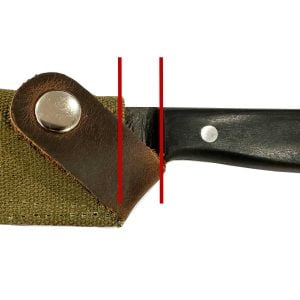Instructions:
- The fillet knife is extremely sharp so we had to design a plastic insert in the sheath to ensure the knife can be safely stored.
- Do not try to push the knife in all the way in the sheath. It was designed to stick out a from the sheath in order for the leather strap to catch onto the knife to keep it safely in the sheath.
- Attaching the clip might be a little difficult at first but the leather should stretch after time, making it easier to attach the clip.
- The blade is flexible but still has it’s limits and can bend if not used correctly.
- DO NOT use the coarse slot of a sharpener to sharpen the blade. The fillet knife is very thin and can easily get damaged if not sharpened correctly.
The FireChef Chef’s Fillet Knife is a masterclass in design and functionality. Crafted from X50CrMoV15 German Steel, this knife is a testament to precision and durability. With a blade length of 190 mm and a total length of 300 mm, it’s designed for the specific needs of filleting. The Pakkawood handle, synonymous with the finest Japanese knives, ensures a comfortable grip and adds an aesthetic touch. Weighing just 100 g, it’s lightweight yet robust.
Understanding the Fillet Knife: A fillet knife is distinct from other knives. It’s designed to be thin and flexible, allowing for precise cuts when filleting fish. This design ensures that you can navigate around the bones and get clean fillets. However, it’s essential to understand that a fillet knife is not meant for cutting through bones. Using it as such can damage the blade.
Why Pakkawood? Pakkawood, a composite material made from layers of wood veneers bonded with a phenolic resin, offers the best of both wood and plastic. It’s incredibly durable, resistant to water and heat, and boasts a beautiful appearance with intricate grain patterns. This material, often found in high-end Japanese knives, ensures that the handle is both functional and elegant.
Maintaining Your Fillet Knife:
-
Cleaning: Hand-wash your knife with a mild detergent and warm water. Avoid abrasive scouring pads. Dry immediately with a soft cloth.
-
Storage: Use a knife block, magnetic strip, or the original canvas sheath to store your knife, protecting the blade from potential damage.
-
Honing and Sharpening: Regularly hone your knife to keep the blade aligned. When sharpening, remember that the blade is designed with a 16 degree angle. Maintain this angle for optimal results.
-
Avoid the Dishwasher: The dishwasher’s harsh environment can damage both the blade and the Pakkawood handle. Always opt for hand-washing.
-
Use the Right Cutting Surface: Always use a soft cutting board, such as wood or rubber. Hard surfaces can dull or damage the blade.
-
Safe Handling: Handle your knife with care. Offer the handle first when handing it to someone. Ensure the blade edge isn’t facing outward when laying it down.
-
Understand Its Purpose: Remember, the fillet knife is designed for filleting, not for cutting through bones. Using it for the wrong purpose can damage the blade.
In conclusion, the FireChef Chef’s Fillet Knife is a blend of tradition and innovation. By following these care guidelines, you ensure that your knife remains a trusted tool in your culinary journey for years to come.







